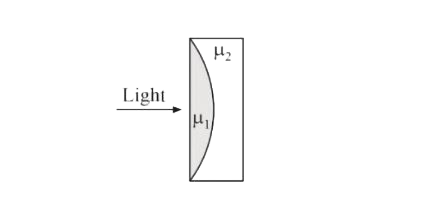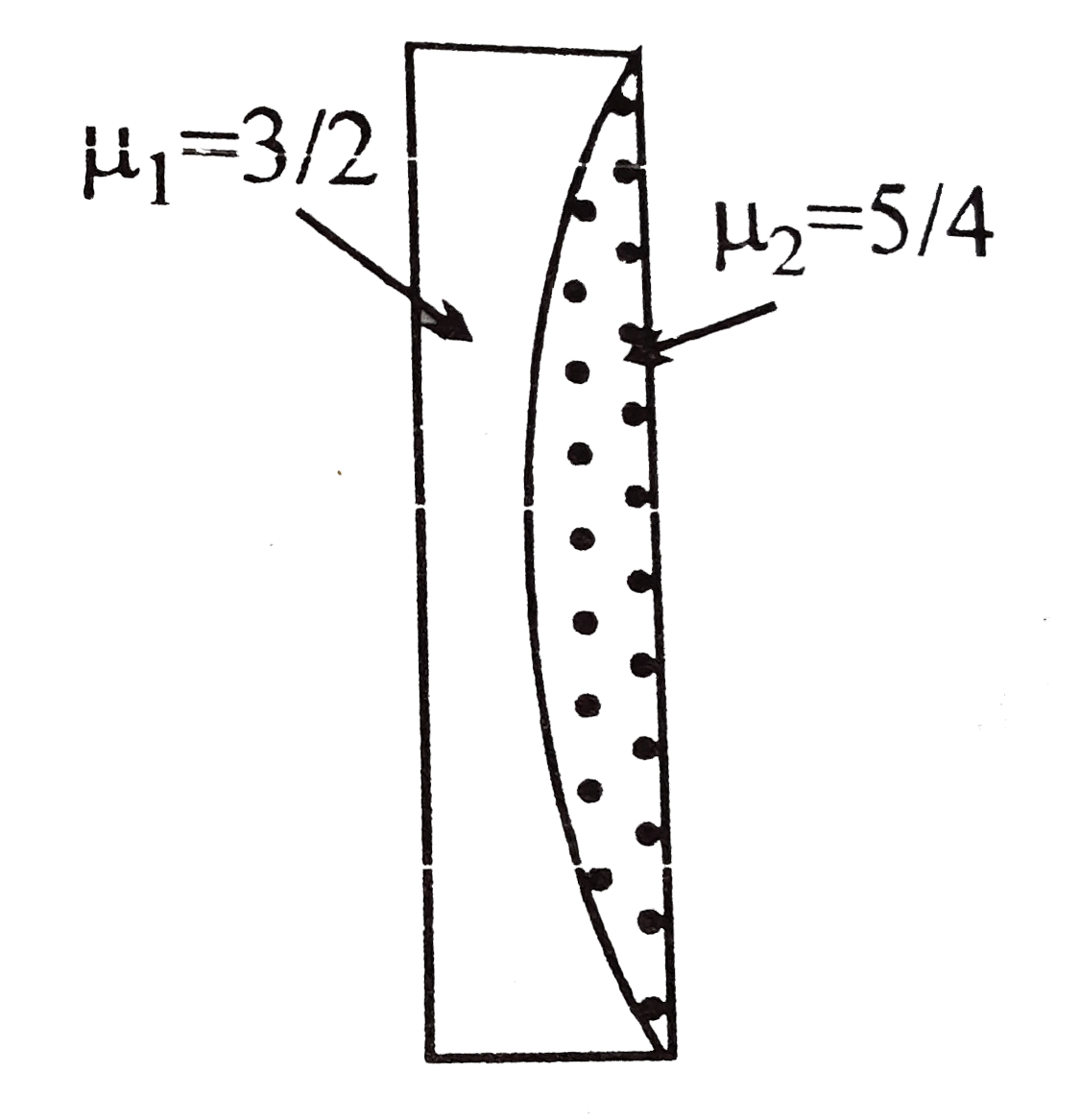A plano-convex lens fits exactly into a plano-concave lens. Their plane surfaces are parallel to each other. If the lenses are made of different material of refractive indices and and R is the radius of curvature of the curved surface of the lenses, then focal length of the combination is
The correct Answer is:C
To find the focal length of the combination of a plano-convex lens and a plano-concave lens, we can follow these steps:
Step 1: Understand the Lens Configuration
We have two lenses:
- A plano-convex lens with a refractive index μ1 and a radius of curvature R.
- A plano-concave lens with a refractive index μ2 and the same radius of curvature R.
Step 2: Apply the Lens Maker's Formula
The lens maker's formula is given by:
1f=(μ−1)(1R1−1R2)
For the plano-convex lens:
- The first surface (plane) has an infinite radius of curvature, so R1=∞ (which gives 1R1=0).
- The second surface (convex) has a radius of curvature R, so R2=R.
Thus, for the plano-convex lens:
1f1=(μ1−1)(0−1R)=−μ1−1R
This simplifies to:
1f1=1−μ1R
Step 3: Calculate the Focal Length for the Plano-Concave Lens
For the plano-concave lens:
- The first surface (concave) has a radius of curvature R (which is negative in sign convention), so R1=−R.
- The second surface (plane) has an infinite radius of curvature, so R2=∞.
Thus, for the plano-concave lens:
1f2=(μ2−1)(−1R−0)=−μ2−1R
This simplifies to:
1f2=1−μ2R
Step 4: Combine the Focal Lengths
The formula for the focal length of the combination of two lenses is:
1f=1f1+1f2
Substituting the values we found:
1f=1−μ1R+1−μ2R
Combining the fractions:
1f=(1−μ1)+(1−μ2)R=2−μ1−μ2R
Step 5: Solve for the Focal Length f
Taking the reciprocal gives us:
f=R2−μ1−μ2
Final Result
The focal length of the combination of the plano-convex and plano-concave lenses is:
f=Rμ1−μ2
We have two lenses:
- A plano-convex lens with a refractive index μ1 and a radius of curvature R.
- A plano-concave lens with a refractive index μ2 and the same radius of curvature R.
The lens maker's formula is given by:
1f=(μ−1)(1R1−1R2)
For the plano-convex lens:
- The first surface (plane) has an infinite radius of curvature, so R1=∞ (which gives 1R1=0).
- The second surface (convex) has a radius of curvature R, so R2=R.
1f1=(μ1−1)(0−1R)=−μ1−1R
This simplifies to:
1f1=1−μ1R
For the plano-concave lens:
- The first surface (concave) has a radius of curvature R (which is negative in sign convention), so R1=−R.
- The second surface (plane) has an infinite radius of curvature, so R2=∞.
1f2=(μ2−1)(−1R−0)=−μ2−1R
This simplifies to:
1f2=1−μ2R
The formula for the focal length of the combination of two lenses is:
1f=1f1+1f2
Substituting the values we found:
1f=1−μ1R+1−μ2R
Combining the fractions:
1f=(1−μ1)+(1−μ2)R=2−μ1−μ2R
Taking the reciprocal gives us:
f=R2−μ1−μ2
The focal length of the combination of the plano-convex and plano-concave lenses is:
f=Rμ1−μ2
Similar Questions
A plano convex lens fits exactly into a plano concave lens. Their plane surfaces are parallel to each other. If the lenses are made of different materials refractive indices μ1 and μ2 and R is the radius curvature of the curved surface of the lenses, the focal length of the combination is
View SolutionA plano convex lens fits exactly into a plano concave lens. Their plane surfaces are parallel to each other. If the lenses are made of different materials refractive indices μ1 and μ2 and R is the radius curvature of the curved surface of the lenses, the focal length of the combination is
View Solution
Knowledge Check
What is the refractive index of material of a plano-convex lens , if the radius of curvature of the convex surface is 10 cm and focal length of the lens is 30 cm ?
A65B74C23D43
A plano convex lens fits exactly into a plano concave lens. Their plane surfaces are parallel to each other. If lenses are made of different materials of refractive index μ1=4/3 and μ2=6/5 and R = 40 cm is the radius of curvature of the curved surface of the lenses, then the focal length of combination (in meters) is.

View SolutionA plano convex lens fits exactly into a plano concave lens. Their plane surfaces are parallel to each other. If lenses are made of different materials of refractive index μ1=4/3 and μ2=6/5 and R = 40 cm is the radius of curvature of the curved surface of the lenses, then the focal length of combination (in meters) is.

View SolutionA thin plano-convex lens fits exactly into a thin plano-concave lens. Their plane surfaces are parallel to each other. The lenses are made of different material of refractive indices μ1 and μ2 and R is the radius of curvature of the curved surfaces of the lenses, if rays are incident parallel to principal axis on lens of refractive index.
View SolutionA planocovex lens is made of a material of refractive in μ=1.5 The radius of curvature of curved surface of the lens is 20.cm. If its plane surface3 is silvered, the focal length of the silvered lens will be
View SolutionFind the refractive index of the material of a plano-convex lens, if the radius of curvature of the convex surface is 20 cm and focal length of the lens is 60 cm?
View SolutionA thin plano-convax lens fits exactly into a plano concave lens with their plane surface parallel to each other as shown in the figure.the radius of the curvature of the curved surface R=30cm The lens are made of different material having refractive indexμ1=32and μ2=54as shown in the figure

(i) if plane surface of the plano -convex lens is silvered,then calculate the equivalent focal length of this system and also calculate the nature of this equivalent mirror .
(ii) An object having transverse length 5cmis placed on the axis of equivalent mirror(in part1)atadistance15cm from the equivalent mirror along principal axis.Find the transverse magnification produced by equivalents mirror.
View SolutionThe plane surface of a plano-convex lens of refracting index 1.5, is silvered. The radius of curvature of curved surface is R. Find the focal length of the mirror thus formed.
View Solution
